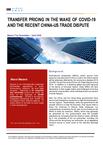April 2020 - TRANSFER PRICING IN THE WAKE OF COVID-19 AND THE RECENT CHINA-US TRADE DISPUTE
Transfer Pricing and China-US Trade Dispute
Both the China and the Hong Kong governments have announced emergency measures to help the businesses in the two regions. Nevertheless, while the governments will provide stimulus to help the economy, they would need to boost tax revenues to finance these measures, not necessarily by increasing the tax rate, but by looking at the MNEs to raise tax revenues. MNEs, which may generally be perceived by the governments and the broader population as not paying their fair share of taxes, will likely be in the crosshairs of the tax authorities, including the China and the Hong Kong tax authorities, as an appealing revenue source to cover some of the recovery package costs.
Transfer Pricing Documentations and Tax Audits
The profit margins of these MNEs would be adversely affected by disruptions caused by the recent China-US Trade Dispute, which lasted for more than a year till Phase I of the Trade Agreement was signed on 15 January, 2020 and the COVID-19 outbreak.
Given that tax audits are often retrospective in nature, and also the 2020 Transfer Pricing Documentations would be prepared in 2021, these MNEs would be facing challenges by the tax authority in the underlying transfer pricing arrangements after the year 2020 ends. To defend themselves, MNEs must be able to explain to the tax authorities that their transfer pricing arrangements were valid during 2020, but there were unexpected deviations caused by extraordinary adverse factors beyond their control, i.e. business disruptions caused by the above two circumstances. We generally term these unexpected deviations as “special factors”.
This is particularly critical in cases of so-called routine enterprises, which are assumed to achieve low but stable margins. For example, a Chinese subsidiary in a multinational group may only be a routine contract manufacturer which does not undertake any significant risk. It is often the position of the China tax authority that it should not have a high profit margin, and it should not suffer loss either, even the routine margin could be reduced to some extent. If there is a loss, it must be explained by special factors.
Nevertheless, before a tax authority would accept a special factor analysis, it must be supported by a quantitative analysis, rather than merely a qualitative explanation. For example, the disruption could be caused by a shut-down of the manufacturing factory for one month. It would not be convincing just by saying the factory has been closed down for one month. Often, the economic impact would need to be quantified to contribute to the deviation. The close down would likely cause an under-absorption of fixed costs, in-efficient utilization of labors and compensation of damages to suppliers, etc. All these would need to be quantified. While the industry as a whole would be affected, such that the comparable companies would show a deviation as well, the economic impact is often different between the tested entity and the comparable companies.
It is imperative that taxpayers should document their transfer pricing arrangement now, including a discussion of the extraordinary effects arisen from the Trade Dispute and the COVID-19 and any other extenuating market or business-related factors, to memorialize these positions in defence of a potential future audit covering the tax years concerned.
The finance department should start collecting the relevant data to compile the economic impact of the un-expected deviations from the special factors, and seek help from their professional advisers in this regard.
Change in Transfer Pricing Arrangements
In the wake of the China-US Trade Dispute and the COVID-19, in certain cases, it may be necessary for the MNEs to alter their transfer pricing arrangements. Some MNEs may have to modify their supply chains due to disruptions in China hit hard by the increase in Custom Duties in the US or disruptions hit hard by COVID-19. Such changes would lead to discrepancies between the historical transfer pricing positions taken with respect to the traditional supply chains and the altered structures necessitated by the China-US Trade Dispute and COVID-19. The MNEs should revisit their transfer pricing arrangements to ensure that they match their current supply chain and fact patterns. If there are significant discrepancies, certain transfer pricing arrangements would need to be changed.
Effects on Existing License Agreements
For MNEs which are selling in the China and Hong Kong markets, the recent China-US Trade Dispute and the COVID-19 would have impact on royalties that need to be paid to the overseas related licensors. Generally, the amount of royalties could be based on revenue or based on profits with certain basic amounts. Should the royalty rate be adjusted? This has to be considered by the MNEs.
Mazars’ Thoughts
All the above items should be addressed by the management in the wake of the year-long trade dispute between China and the US and the COVID-19 outbreak. Though it is currently unclear as to how long the COVID-19 pandemic will last, it is clear that the economy will be profoundly affected. Professional advice should be sought for preparing changes to the transfer pricing arrangements, as well as for preparing the transfer pricing documentation to address any impacts brought on by the recent China-US Trade Dispute and the COVID-19. Mazars can assist the management in this regard.

